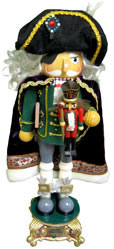Believe it or not, the humble nutcracker has a story that goes well beyond simple history. With the rise of man came the rise of tools, the two being inextricably linked.  At first, these tools were crude and often consisted of a pair of rocks banged together for effect. This is how early man smashed open nuts to enjoy the treat inside. Over the centuries, though, brass and wood were used to make the iconic tool. It was around the 16th century when the versions that we’re familiar with began to take shape.
At first, these tools were crude and often consisted of a pair of rocks banged together for effect. This is how early man smashed open nuts to enjoy the treat inside. Over the centuries, though, brass and wood were used to make the iconic tool. It was around the 16th century when the versions that we’re familiar with began to take shape.
The original nutcracker story is set in Europe, particularly among small villages in England, Switzerland, France and Germany. However, it is in Sonneberg and Erzgebirge, a pair of German regions, where the carvings really took hold. Here, many villagers worked in the mines as the area was flush with valuable mineral deposits. When the icy grip of winter approached each year, the miners were forced back into their homes where they spent much of their time carving wood. These carvings took on many shapes and styles, but eventually the villagers found inspiration that would last for centuries.
The villagers of Soneberg and Erzgebirge long suffered under the hands of their superiors, who took the mined ores and used them for their devices. In response, the villagers’ carvings started taking on the shape of local rulers and authorities, exaggerating their features in a form of light mockery and irony. From these carvings emerged the toy soldiers and kings that are now so familiar. Eventually, the mineral deposits ran dry and the villagers had to produce their carvings year round to maintain their incomes. Soon enough, the toy soldiers and kings were associated with the German regions and their carvings were sold all over Europe.
By the middle of the 18th century, the nutcracker and its story followed a steady upward trend. By then, the practice of carving the tools into the shape of people had become widely accepted, and the tools even began inspiring fiction. Perhaps the most important piece of this fiction was Nussknacker und Mausekönig, or The Nutcracker and the Mouse King. It was written in 1816 by E.T.A. Hoffman and itself was the inspiration for one of the most iconic Christmas stories of all time, Tchaikovsky’s The Nutcracker.
However, the tool never lost its capacity for social commentary and irony. Even into the late 19th century, they were carved in the shape of unpopular political figures and local police. Of course, such commentary likely went over the heads of the mocked rulers, but it was a way for working class people to get a laugh behind the backs of the powerful.
Many of today’s carvings are still done by hand and produced by expert craftsmen and women. The process can take years to complete, with hundreds of little tasks from start to finish. However, the result is an intricately shaped and painted figure, infused with centuries of tradition and history.
